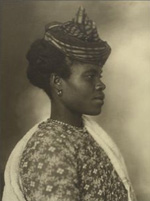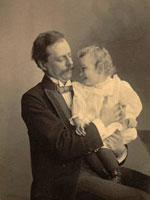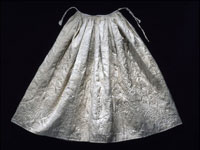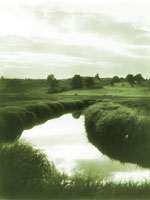Here I imagine you handing me a big stick and inviting me to climb up an ancient oak and swat a huge, low hanging hornet's nest.
The question of who designed the American flag is, as they say, "contested" and has been so for 140 years. You may wonder "Why only that long?" "What about the century before that, back to the founding of the nation?" "What did people think then?"
The answer seems to be that people thought the American flag simply evolved during the Revolutionary War from other flags and ensigns used in the British empire. The Continental Congress passed a flag resolution on June 14, 1777, that read: "Resolved. That the flag of the United States be 13 stripes alternate red and white, that the Union be 13 stars white in a field of blue representing a new constellation." This resolution, however, was submitted to Congress by its Marine Committee, among other resolutions concerning the navy and shipping. It is unclear whether the flag resolution was understood at the time to have established a national standard per se, or only a naval ensign.
A letter written on May 10, 1779, from the Board of War (the Continental Congress' War Office) to George Washington, who was then encamped with his army at Middlebrook, New Jersey, underscores the uncertainty. It suggests that almost two years after the flag resolution, an official flag for the United States had not yet been set. The letter says, in part:
"It was intended that every Regiment should have two Colours—one the Standard of the United States which should be the same throughout the Army, & the other a Regimental Colour which should vary according to the facings of the Regiments. But it is not yet settled what is the Standard of the U. States. If your Excellency will therefore favor us with your Opinion on the Subject we will report to Congress & request them to establish a Standard & so soon as this is done we will endeavor to get Materials and order a Number made sufficient for the Army."
Even if there was uncertainty during this period about the flag, however, it was in fact the design as described in the flag resolution that stood alone by about 1783 as the design of the American flag. Flags were handmade during this time, however, and flags varied in the length and width of the red and white stripes, the proportion of the blue field to the stripes, the number of points on the stars, and the shape of the "constellation" of the stars on the blue field, none of which were described in the flag resolution.
Frances Hopkinson of New Jersey, a signer of the Declaration of Independence, was an official with the Continental Congress' Navy Board at the time the flag resolution was passed in 1777. After the war, he submitted a letter to the government asking to be paid for designing that flag. His request was refused, apparently because he had been an employee of the government at the time and because, it was said, "many people" had contributed to the flag design.
When new states were brought into the Union, the flag was changed to add stars (and, at first, stripes). Congress legislated this in 1794 and then, in a more detailed way, in 1818.
Most of this history was well known to researchers in the first half of the 19th century. The standard published authorities on the history of the flag consulted during this time were Schuyler Hamilton, The History of the National Flag of the United States of America (Philadelphia: Lippincott, Grambo and Company, 1852), and Ferdinand L. Sarmiento, The History of Our Flag: From the Earliest Period of Our Colonial Existence down to the Present Time (Philadelphia: A. Winch, 1864).
The Hornet's Nest
In 1870, William J. Canby delivered a paper before the Pennsylvania Historical Society, "The History of the Flag of the United States". In it, Canby related a story that his grandmother had told him before she died, in 1836, when he was 6 years old.
In 1776, she had told him, when she was a young widow, she was living on Arch Street in Philadelphia, and doing business there as an upholsterer and seamstress. Her name then was Elizabeth (that is, Betsy) Ross. One day that summer a special committee of the Continental Congress, composed of financier Robert Morris and George Ross (the uncle of her deceased husband), accompanied by George Washington, paid her a visit. Washington, said Canby, showed her a rough design for a national flag and asked her if she could make one based on the design. As Canby told it, Betsy Ross suggested a few changes in the design, to which Washington assented, including making the stars five-pointed instead of six-pointed. When the committee returned after a few days, Betsy presented them with the flag she had made and they were delighted with it, returning with it to Congress, which approved it as the national emblem.
There is no documentary evidence for any of this dating from that time, except to support the fact that Canby's grandmother, Betsy Ross, was indeed in business as an upholsterer and seamstress on Arch Street, and that government records do show that she was later reimbursed for sewing a naval ensign for a squadron of Pennsylvania ships. The only evidence Canby had to offer for his story was "family tradition," that is, a story that his grandmother had told him 36 years previously about something that she said had happened to her 60 years before that. To support his story, he collected affidavits from his aunts—Betsy's daughters (who had not been born in 1776)—and an aged cousin, all of whom affirmed that they had heard Betsy tell this story.
Canby then began an intense correspondence with naval officer, historian, and writer George Henry Preble, who was then working on a book about the history of the American flag, and convinced Preble to include the story of Betsy Ross in Preble's meandering footnotes in the volume he published in 1872, Our Flag: Origin and Progress of the Flag of the United States of America (Albany: Joel Munsell, 1872).
The following year, Canby's story was picked up and retold uncritically in an article in the widely-read Harper's New Monthly Magazine, which brought the story of Betsy Ross and the flag to a large popular audience. [H. K. W. Wilcox, "National Standards and Emblems," Harper's New Monthly Magazine, vol. 47, issue 278 (July 1873): 171-181]. The nation's daily newspapers also ran many feature stories on the birth of the flag, incorporating Canby's story.
Five years later, another Betsy Ross descendant, J. Franklin Reigart, published The History of the First United States Flag, and the Patriotism of Betsy Ross, the Immortal Heroine That Originated the First Flag of the Union ["Dedicated to the Ladies of the United States by Col. J. Franklin Reigart."] (Harrisburg, PA: L.S. Hart, 1878), which embellished the tale considerably. Reigart seems to have been motivated by a combination of family pride and a notion of chivalry that required that he "make way for the ladies." His own embroidery of the tale had Betsy not only creating the design herself based only on the sketchiest of preliminary ideas offered by Washington, but also had her, based on a "prophetic vision," sewing the words "United States of America" on the hem of the flag, thus inventing the name of the country as well. Reigart's book was received skeptically, to put it mildly, by contemporary historians.
William Canby's brother, George, took up the family tradition and continued to collect material that might support the Betsy Ross story. His nephew, Lloyd Balderston, published this material in 1909 in his book, The Evolution of the American Flag: from materials collected by the late George Canby (Philadelphia: Ferris & Leach, 1909).
Other Ross descendants also contributed their efforts on behalf of their ancestor. Oliver Randolph Parry authored Betsy Ross and the United States Flag: Philadelphia Woman Maker of the First Standard. A paper read before the Bucks County Historical Society, at Doylestown, Pa., January 19, 1909 (Philadelphia: 1909), and Edwin Satterthwaite Parry, a great-great-grandson of Betsy, published Betsy Ross, Quaker Rebel: Being the True Story of the Romantic Life of the Maker of the First American Flag (Philadelphia: John Winston Company, 1930).
A Ross descendant in the current generation has continued the defense of the story. After having read a 1972 article in the Wall Street Journal that described the Betsy Ross story as a myth (Valerie Reitman, "Tale of Betsy Ross, It Seems, Was Made Out of Whole Cloth: A Grandson Spun a Flag Story, Then Sold It to America; Now Part of Nation's Fabric," Wall Street Journal, June 12, 1992, pp. A1-A2), Ross descendant John Balderston Harker took up his pen at the challenge to the family escutcheon and has published Betsy Ross's Five Pointed Star, Elizabeth Claypoole, Quaker Flag Maker—A Historical Perspective (Melbourne Beach, FL: Canmore Press, 2005).
During the 1890s, the Betsy Ross story was spread more widely still when the American Flag House and Betsy Ross Memorial Association was founded by private investors who wished to buy, restore, and preserve the building on Philadelphia's Arch Street that they had identified as Betsy Ross's house. Schoolchildren across the nation were asked to send in their dimes to contribute to the project. They received in return certificates on which was printed a reproduction of a fanciful painting done by Charles Weisgerber of Betsy Ross presenting her flag (with the stars in a circle) to Washington, Morris, and Ross. Notably, most of the books published on Betsy Ross have been written for children and have approached the story uncritically. Reproductions of Weisgerber's painting have appeared in history textbooks around the country.
Nevertheless, a few books written by researchers outside the circle of Betsy Ross descendants have been sympathetic, to one degree or another, to the Betsy Ross story. They include:
Ray Thompson. Betsy Ross: Last of Philadelphia's Free Quakers (Fort Washington, PA: Bicentennial Press, 1972).
Robert Morris. The Truth About the Betsy Ross Story (Beach Haven, New Jersey: Wynnehaven Publishing Company, 1982).
William D. Timmins. Betsy Ross, the Griscom Legacy (Salem County, New Jersey: Cultural and Heritage Commission, 1983).
Naysayers
Most of the historians who have looked into the history of the flag have been highly skeptical of the Betsy Ross story, even as the public has embraced it. About the most positive statement that the consensus of historians' opinion can deliver is that someone might have asked Betsy Ross at some time to make a flag of some design that some American military or naval force could use. Beyond that, everything is up in the air.
Historians have pointed to inconsistencies and historical improbabilities in the story. They have also pointed to its tenuous foundation: hearsay testimony of a family member first revealed to the public 94 years after the event. Finally, they have pointed to the ways in which the story has been used as a kind of promotional device in selling things or ideas to the public. Beyond the funding of tourist sites and historical memorials in Philadelphia, and all the patriotic gewgaws and paraphernalia associated with Betsy Ross, historians have also pointed to several ideas that late 19th century promoters of one kind or another were eager to "sell" to the public. These included the necessity of national unity at a time when north and south were still healing from the divisions of the Civil War and when new waves of immigrants were arriving on the country's shores. Ideas that would get Americans to rally around the flag—such as the institution of Flag Day, the introduction of the Pledge of Allegiance, and the story of Betsy Ross—helped in this.
In addition, through the story of Betsy Ross, women could be brought into the patriotic stories of the country's founding at the time of the Revolution. Historians have argued that the story of Betsy Ross offered the country a way of incorporating the rising sentiment toward women's rights into a narrative that simultaneously added a woman into the ranks of America's founders, but also reinforced women's traditional domestic role of seamstress. In some of the more fantastic elaborations, the story also portrayed Betsy Ross as the Mother of Her Country, visited by Washington, the Father of His Country, and, through their mysterious union, bringing about what one historian has referred to as the "immaculate conception" of the flag, if not the entire idea of the country itself. The story's popularity evidently draws on some deep cultural roots apart from the lack of historical evidence to support it.
The story of Betsy Ross has echoes in the story of a young Baltimore widow, Mary Young Pickersgill. According to that story, the commander of Fort McHenry, Major George Armistead, had a committee of his officers call on Pickersgill in 1813 and commission her to sew a huge American flag to fly over the fort. After sewing it together, she delivered it to them, and it was this flag that flew over the fort when the British bombarded it in September 1814. It was her flag that inspired Francis Scott Key to write "The Star-Spangled Banner," and it is this same flag that is now on display at the Smithsonian's Museum of American History. This flag had been long stored away by a private owner, a descendant of Major Armistead, but was found, unfolded, and photographed for the first time in 1873 by George Preble when he was doing the research for the book he wrote on the history of the flag, during which time he was in correspondence with William Canby.





